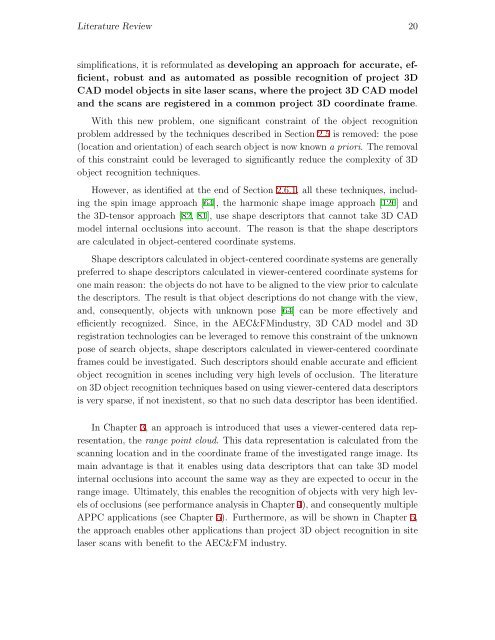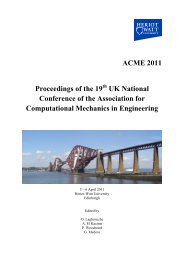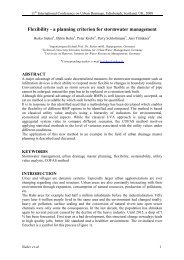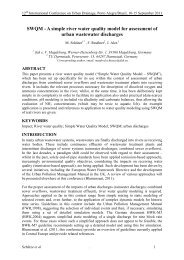PhD Thesis - Automated Recognition of 3D CAD Model Objects in ...
PhD Thesis - Automated Recognition of 3D CAD Model Objects in ...
PhD Thesis - Automated Recognition of 3D CAD Model Objects in ...
Create successful ePaper yourself
Turn your PDF publications into a flip-book with our unique Google optimized e-Paper software.
Literature Review 20<br />
simplifications, it is reformulated as develop<strong>in</strong>g an approach for accurate, efficient,<br />
robust and as automated as possible recognition <strong>of</strong> project <strong>3D</strong><br />
<strong>CAD</strong> model objects <strong>in</strong> site laser scans, where the project <strong>3D</strong> <strong>CAD</strong> model<br />
and the scans are registered <strong>in</strong> a common project <strong>3D</strong> coord<strong>in</strong>ate frame.<br />
With this new problem, one significant constra<strong>in</strong>t <strong>of</strong> the object recognition<br />
problem addressed by the techniques described <strong>in</strong> Section 2.5 is removed: the pose<br />
(location and orientation) <strong>of</strong> each search object is now known apriori.Theremoval<br />
<strong>of</strong> this constra<strong>in</strong>t could be leveraged to significantly reduce the complexity <strong>of</strong> <strong>3D</strong><br />
object recognition techniques.<br />
However, as identified at the end <strong>of</strong> Section 2.6.1, all these techniques, <strong>in</strong>clud<strong>in</strong>g<br />
the sp<strong>in</strong> image approach [64], the harmonic shape image approach [126] and<br />
the <strong>3D</strong>-tensor approach [82, 81], use shape descriptors that cannot take <strong>3D</strong> <strong>CAD</strong><br />
model <strong>in</strong>ternal occlusions <strong>in</strong>to account. The reason is that the shape descriptors<br />
are calculated <strong>in</strong> object-centered coord<strong>in</strong>ate systems.<br />
Shape descriptors calculated <strong>in</strong> object-centered coord<strong>in</strong>ate systems are generally<br />
preferred to shape descriptors calculated <strong>in</strong> viewer-centered coord<strong>in</strong>ate systems for<br />
one ma<strong>in</strong> reason: the objects do not have to be aligned to the view prior to calculate<br />
the descriptors. The result is that object descriptions do not change with the view,<br />
and, consequently, objects with unknown pose [64] can be more effectively and<br />
efficiently recognized. S<strong>in</strong>ce, <strong>in</strong> the AEC&FM<strong>in</strong>dustry, <strong>3D</strong> <strong>CAD</strong> model and <strong>3D</strong><br />
registration technologies can be leveraged to remove this constra<strong>in</strong>t <strong>of</strong> the unknown<br />
pose <strong>of</strong> search objects, shape descriptors calculated <strong>in</strong> viewer-centered coord<strong>in</strong>ate<br />
frames could be <strong>in</strong>vestigated. Such descriptors should enable accurate and efficient<br />
object recognition <strong>in</strong> scenes <strong>in</strong>clud<strong>in</strong>g very high levels <strong>of</strong> occlusion. The literature<br />
on <strong>3D</strong> object recognition techniques based on us<strong>in</strong>g viewer-centered data descriptors<br />
is very sparse, if not <strong>in</strong>existent, so that no such data descriptor has been identified.<br />
In Chapter 3, an approach is <strong>in</strong>troduced that uses a viewer-centered data representation,<br />
the range po<strong>in</strong>t cloud. This data representation is calculated from the<br />
scann<strong>in</strong>g location and <strong>in</strong> the coord<strong>in</strong>ate frame <strong>of</strong> the <strong>in</strong>vestigated range image. Its<br />
ma<strong>in</strong> advantage is that it enables us<strong>in</strong>g data descriptors that can take <strong>3D</strong> model<br />
<strong>in</strong>ternal occlusions <strong>in</strong>to account the same way as they are expected to occur <strong>in</strong> the<br />
range image. Ultimately, this enables the recognition <strong>of</strong> objects with very high levels<br />
<strong>of</strong> occlusions (see performance analysis <strong>in</strong> Chapter 4), and consequently multiple<br />
APPC applications (see Chapter 5). Furthermore, as will be shown <strong>in</strong> Chapter 5,<br />
the approach enables other applications than project <strong>3D</strong> object recognition <strong>in</strong> site<br />
laser scans with benefit to the AEC&FM <strong>in</strong>dustry.













